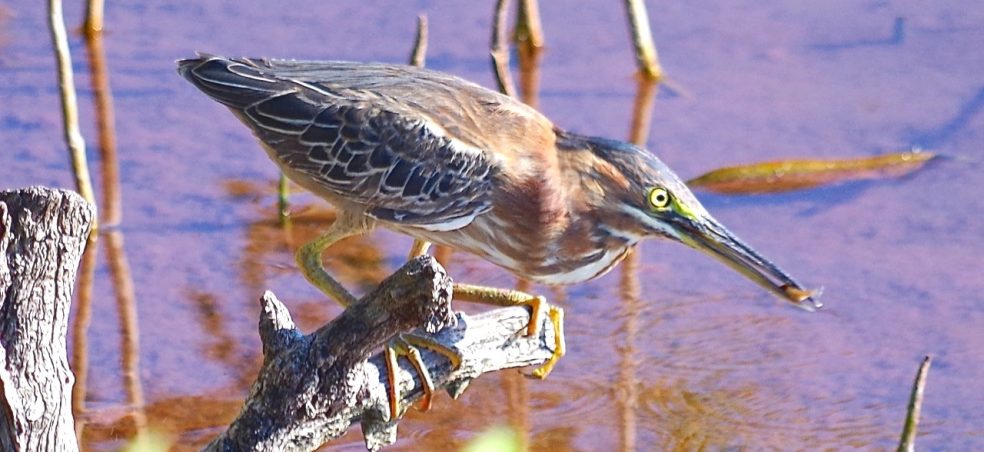OSPREYS: ID GUIDE TO THE BAHAMAS SUBSPECIES
I have featured bird comparatives from time to time, not least because scope for confusion meant that I needed to investigate for my own peace of mind. These included the tyrant flycatchers; a number of superficially similar warbler species (mostly with yellow bits); varied vireos; all those heron-y / egret-y types and their disconcerting morphs (hello, white reddish egret).
And so to the magnificent osprey Pandion haliaetus. This time, the comparison is between two subspecies, broadly the North American P. h. carolinensis and the Caribbean P.h. ridgwayi. There is some overlap in Florida, and some evidence of interbreeding. In the northern Bahamas in particular there is also an overlap, so an osprey seen on Abaco could be either variety. You’ll probably be too excited watching it to care much which type it is, but this article will help you if you do…
The two ospreys shown below were photographed at Spanish Wells, Eleuthera by Barbara Crouchley. This is a ‘bingo’ photographic scoop, because each type of bird was found in the same region; now we can check out the differences between the two birds.
The first is a North American bird. Note in particular its distinctive eye mask, and the clearly marked upper breast – more so in the female than the male (which may even be white). The overall impression of the upper-parts is dark brown. They are slightly larger than their cousins in the south.
In this Caribbean bird, below, with its trophy fish, the eye-mask is absent and the facial / nape markings are less pronounced. Furthermore, the breast and under-parts are white in both sexes (though slight marking may be apparent in some birds). And the impression is of lighter upper-parts, even allowing for variable lighting and distance when the photos were taken. Conveniently, there’s not much detectable difference between male and females in the respective populations.
EXAMPLES OF P. h. carolinensis
EXAMPLES OF P. h. ridgwayi
THE EYES HAVE IT?
After I had looked into the noted distinctions I wrote “I’m going to stick my neck out here – I’ve not seen this mentioned anywhere, and I need to do some more comparative research”. When I saw Barbara’s pair of photos, I noticed that the eyes of the P.h.r were much paler compared with the bright orangey-yellow of P.h.c. This distinction is found in all the comparative photos above. The P.h.cs were photographed in Florida and further north and have the strikingly vivid eyes. The P.h.rs were photographed on Abaco and Grand Bahama at different times by different people. All have noticeably paler irises, more a light greeny-yellow.
I haven’t seen this commented on since my original piece, but if anyone has a view it would be welcome.
UNDERWING DIFFERENCES
There’s a further comparison that can be made with the two subspecies in flight. Without going into technical and linguistic detail, the underwings of the P.h.cs are much darker than the Bahamas birds, whereas P.h.rs are notably paler and in some cases mostly white. As an example, below is a distance shot I took when bonefishing out on the Abaco Marls, with a small pocket camera in one hand and a rod in the other. This is definitely a local bird! Compare with the dramatic image below it, where the strong darker markings are all too evident. It’s a great shot with which to bring the lesson to an end.
ADDENDUM: Thanks to LSulikM for pointing out that female carolinensis (besides being larger than males) have frontal freckling, sometimes called a necklace, that is a prominent ID marker (see bottom image). Males may also have freckling but it is much less conspicuous. For ridgwayi the freckling is absent or (see the bird on the utility pole above) very sparse.
Photo credits: Tom Sheley (1); CWFNJ (2); Barbara Crouchley (3, 4); Danny Sauvageau (5, 6, 7); Jim Todd (8); Linda Barry Cooper (9); Woody Bracey (10); Keith Salvesen (11); the inimitable Northside Jim (12). Thanks for all use permissions – also to Steve Connett for the idea! Original post in 2020.













Wonderful pictures and discussion. I understood that female ospreys have a “string of pearls across their breasts” as a way to tell M from F.
LikeLike
Yes and thanks! I should have mentioned it – also that F are larger. I’ll add + a tip of the hat to you…
LikeLike